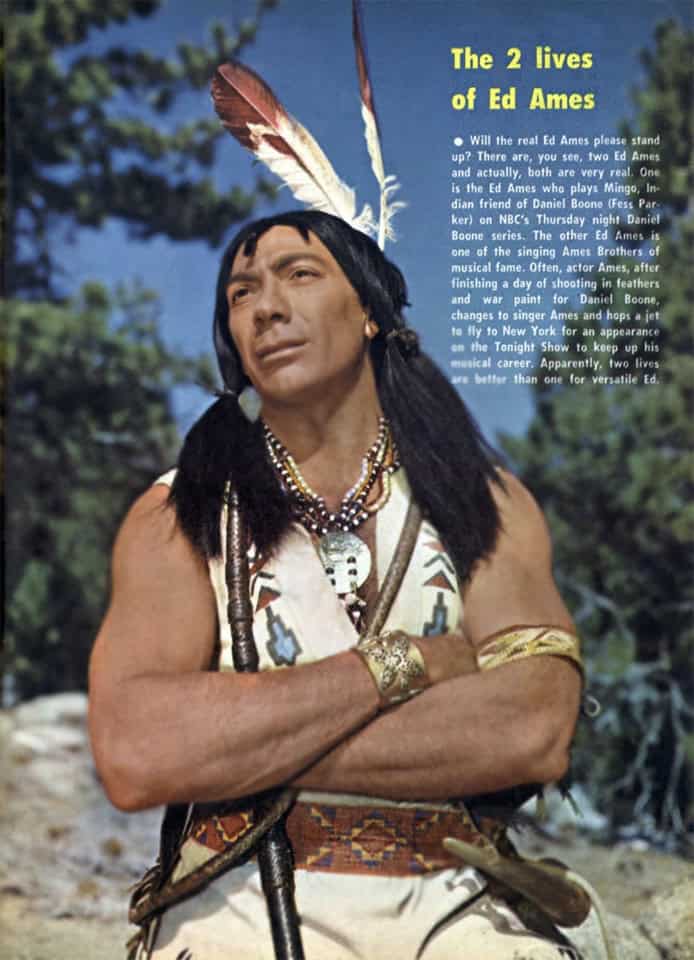By Inna Babitskaya
In 1951, the Ames Brothers had a new hit, “Undecided” (with Les Brown and Band of Renown), that had been written in the 1930s by jazz trumpet player Charlie Shavers. In 1953, the Ames Brothers recorded with Hugo Winterhalter’s Orchestra and Chorus their great hit, the German tune “You, You, You.” A year later, the group made another hit, the novelty song “The Naughty Lady of Shady Lane,” which also sold more than a million copies and was a top-10 hit in the UK. Among their other hits were “Can Anyone Explain?”, “Wang Wang Blues,” “I Wanna Love You,” “My Favorite Song,” “My Bonnie Lassie,” “A Very Precious Love,” “Tammy,” “Melodie d’Amour” and “Pussy Cat.”
During 14 years, the Ames Brothers recorded more than 40 albums, song titles for movies, eight gold records and 50 U.S. chart entries. In 1958 and 1960, Billboard magazine named them their best vocal group of the year. Forty years later, in 1998, the Ames Brothers were inducted into the Vocal Group Hall of Fame.
The Ames Brothers regularly participated in different shows. In 1955–1956, on Friday nights, they even had their own 15-minute TV program, “The Ames Brothers Show,” the first syndicated TV show that was aired abroad.
Though the brothers were very successful with their smooth voices and variety of styles, from folk songs to rhythm and blues, the new rock era required different songs and manners of singing.
Ed’s solo career: acting lessons and “foot in the door”
In 1960, Ed was the first to leave the group. As he later said, “At 30, I found everything stagnant and saw nothing in the future but a repetition of well-painted nothingness.”
He wished to try acting. For nearly two years, he studied it at the School of Acting founded by Austrian-American actor and director Herbert Berghof. (Among its alumni are Al Pacino, Liza Minnelli and Barbra Streisand.) Ames also took private lessons with well-known acting coaches Tamara Daykarhanova, Lee Strasberg and Milton Katselas. Strasberg created a unique system of actors’ training and taught Marlon Brando, Paul Newman and Dustin Hoffman. Katselas, his former student, taught, in turn, George Clooney, Michelle Pfeiffer, Gene Reynolds and others. Lessons with these great professionals were invaluable for Ed and helped him in his acting career.
However, Ed’s first attempts to find a job as a single performer were unsuccessful. He used every possibility in order to find his way on stage. He even began to make commercials and voice-overs, including one for The Walt Disney Studios.
Eventually, his talent, hard work and resilience helped him overcome the obstacles, and he could successfully pursue a theatrical career. He proved the words of Emile Zola: “The artist is nothing without the gift, but the gift is nothing without work.”
As Ed mentioned in 1967, “In the beginning, you keep knocking on doors, and after a lot of hard work, you get your foot in the door. Your foot gets squashed from time to time, but the door is partly open. Suddenly you have a hit record, and those doors fly open.”
Ed on the theater stage: brilliant roles in drama and musicals
This kick-off event happened when, in 1961, he received the starring role of John Proctor in Arthur Miller’s “The Crucible,” the modern adaptation of the Salem Witch Trials. Though this was an off-Broadway production, soon he was invited to play on Broadway as El Gallo in the musical “The Fantasticks,” based on famous French poet Edmond Rostand’s play “The Romancers,” which in turn included elements of the Romanian mythological story “Pyramus and Thisbe,” Shakespeare’s “Romeo and Juliet” and “A Midsummer Night’s Dream” and Donizetti’s opera “The Elixir of Love.” Critics and the audience also applauded his bitter and crippled puppeteer Paul Berthalet from the road show production of Gower Champion’s “Carnival,” and his voice was called one of the finest on the stage.
In 1963, he brilliantly played Indian Chief Bromden in the stage version of Ken Kesey’s novel “One Flew over the Cuckoo’s Nest” (costarring Kirk Douglas and Gene Wilder). In the 1970s and 1980s, Ed Ames starred in the famous John Kenley summer stage productions. Ed Ames played such starring roles as Charlie Anderson in Gary Geld’s musical “Shenandoah,” Tevye in Jerry Bock’s musical “Fiddler on the Roof,” Don Quixote in Mitch Leigh’s “Man of La Mancha” and King Arthur in Frederick Loewe’s “Camelot.”
His role as Emile de Becque in one of the greatest American musicals, “South Pacific,” became his actor’s triumph. Ed’s charisma and psychological depth won the audience momentarily. Ames also starred in the musical version of George B. Shaw’s play “Androcles and the Lion” and played Lord Capulet in the famous Milton Katselas production of “Romeo and Juliet” in Los Angeles.
Ed Ames has successfully directed regional and national companies. In 1994, he was selected for the Performers Hall of Fame in Northern California for excellence in stage performances.
Another outstanding singer, Elvis Presley, said, ‘‘Singers come and go, but if you’re a good actor, you can last a long time.”
According to Ames, his love for acting and singing closely intervened in his career: “Acting is a representation of life. So is singing, and I approach a song as I would a short dramatic scene.”
Ed and TV: from Native American to alcoholic sheriff
Ames’ fantastic performance in “One Flew over the Cuckoo’s Nest,” as well as his appearance (dark eyes and hair and slightly rugged face features), led to his invitation by 20th Century Fox for the role of Mingo, an Oxford-educated Cherokee, in the ABC TV show “Daniel Boone,” about the famous U.S. explorer and frontier. Ames decision to play in the show was based on realistic motives, including reliable payment for the production. As he said in a TV guide in 1968, “You’re an actor, so you act. Work is tight, and if you get a decent part on Broadway every three years, you’re lucky. Whereas you can just keep hackin’ ’em out week after week on TV. And then, of course, you have to eat.”
So, Ames signed a five-year contract with the show, though he was sure that it would not last long. However, his own very talented acting disproved his predictions. The show became a great success. Ames learned how to be a real Indian and played his role without any exaggeration, respecting his character and really living his life. When he performed a Cherokee song of death on the episode “Not in Our Stars,” he sounded authentic; his vocabulary and pronunciation were flawless. Maybe Ed’s linguistic talents helped him with it (he knows half a dozen languages). Ames’ acting was so convincing that many Native Americans considered him one of them. Ames even received a letter from the Arizona Indian Association saying, “You have done more for the Indians by your excellent characterization than all the missionaries, government officials, and book authors combined.”
Despite the huge success of the show, after four years, Ed Ames understood that his singing career was suffering. Also, he didn’t want to always be seen as Mingo. As he explained, “Television series are a great hazard. The more successful the show, the more identified with the characters you become.”
In 1968, he decided to leave the show because he wanted “to do two feature films” and “to go on extended tours… to consolidate my career and… return to Broadway… if the role is right.”
Ed was a guest star on numerous TV dramas and shows as a singer and as an actor. Among them were “Murder, She Wrote,” “Santa Barbara,” “The Rifleman,” “Personality,” “Kraft Music Hall” and “Land’s End.”
His role as the alcoholic sheriff Thompson on “The Heat of the Night” again won the audience. Ames liked the “Heat” script “because it deals with police brutality. It takes another look at ethnic prisoners and the police. It doesn’t turn the guy into a monster. He was a man who had helped people, but when he went bad, there was no system in the community to deal with it.”
To be continued…
(Inna Babitskaya is a Malden historian, a Member of the Malden Historical Commission and author of historical books “From Maldon to Malden,” “Time of Converse” and “Fellsmere Park – Emerald of Malden.”)
See more photo highlights at: www.Facebook.com/advocate.news.ma



